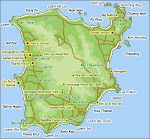
Much of the religious significance has been lost, but the occasion is still used by Thais to pay respect to elders by washing away their sins with a small amount of scented water poured on to the hands and head and symbolises a start to the new year with a clean slate.
The first day of Songkran is an important day to do good deeds. People visit the temples and give alms to the monks. On the second day of the festival Thai people carry sand to the temples to build a small pagoda as part of a merit making ritual. This is called Phra chedi sai and the small sand piles represent the return of the temple dust which worshipers take with them when they leave a temple. People also place flowers or flags on these sand pagodas to enhance their anticipated good luck in the coming year.
The temples themselves traditionally move their holiest of Buddha statues to an outside pavillion for the people to sprinkle water on to purify it. You’ll also see people driving through the streets with Buddha statues in pickup trucks so they can be purified by the people.
Other than these last remnants of tradition, the event has gone mainstream with people of all ages; locals and farangs, lining the streets, or aboard cruising pickups, armed with buckets, hoses and super-soaker squirt guns to dowse all passers by - with a special eye towards foreign tourists.
Double retribution for Mark
I don't know when rice flour and coloured powders became legitimate ammunition - perhaps during a water shortage, but these now are much in evidence, so in addition to becoming soaked, these days, you're also likely to be powdered.
















No comments:
Post a Comment